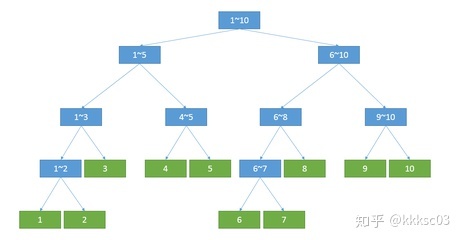线段树详解
|Word Count:32k|Reading Time:1:48mins|Post Views:
线段树的二三事
线段树有什么用?
作为一个比较复杂的数据结构能有如此的知名度,线段树一定有它的拿手绝活,
那么线段树能做什么呢?
简而言之,线段树可以高效地维护区间上对于某个操作结果的信息,
但这个操作必须符合结合律.
最有名的应用就是区间和。当然区间积,最值 (也可以用 ST 表) 也是可以的.
注意:线段树不支持动态添加节点,
因此如果需要修改区间长度的场合不能用线段树
线段树长什么样

从图上可以看出,线段树就是一颗二叉树.
其中的节点管理着一定区间内对应操作的结果.
父节点管理的区间是两个子结点管理的区间的并集.
子节点不断向自己的父亲节点传递信息,
而父节点存储的信息则是他的每一个子节点信息的整合.
线段树就是分块思想的树化,
或者说是对于信息处理的二进制化 -- 用于达到 O (logn) 级别的处理速度.
分块的思想,则可以用一句话总结为:
通过将整个序列分为有穷个小块,对于要查询的一段区间,
总是可以整合成 k 个所分块与 m 个单个元素的信息的并 ()().
但普通的分块不能高效率地解决很多问题,所以作为 log 级别的数据结构,
线段树应运而生.
分块的应用范围还是要广于线段树的,因为虽然线段树好像很快,但是它只能维护带有结合律的信息,比如区间 max/min、sum、xor 之类的,但是不带有结合律的信息就不能维护(且看下文分解);而分块则灵活得多,可以维护很多别的东西,因为实际上分块的本质就是优雅的暴力
我们先定义几个线段树实现中必须的查找函数
inline long long get_mid(long long left_to_manage, long long right_to_manage){
return (right_to_manage - left_to_manage) >> 1 + left_to_manage;
}
inline long long get_left_child(long long position){
return position << 1;
}
inline long long get_right_child(long long position){
return position << 1 + 1;
}
|
def get_mid(left_to_manage, right_to_manage):
return (right_to_manage + left_to_manage) // 2
def get_left_child(position):
return position // 2 + 1
def get_right_child(position):
return position // 2 + 2
|
线段树怎么建
虽然名字叫线段树,但是因为是平衡二叉树,实现的时候常常使用数组.
建树的时候,因为父节点的值又两个子结点决定,因此可以递归建树,
先建好子结点,然后再根据子结点建父节点
void build(long long left, long long right, long long position)
{
if(left == right){
segment_tree[position] = array[left];
return;
}
long long middle = get_mid(left_to_manage, right_to_manage)
build(left, middle, get_left_child(position));
build(middle+1, right, get_right_child(position));
push_up(position);
}
void push_up(long long position){
segment_tree[position] = segment_tree[get_left_child(position)] + segment_tree[get_right_child(position)];
}
void push_up(long long position){
segment_tree[position] = min(segment_tree[get_right_child(position)], segment_tree[get_right_child(position)]);
}
|
def build(left, right, position):
if left == right:
segment_tree[position] = array[position]
return
middle = get_mid(left_to_manage, right_to_manage)
build(left, middle, get_left_child(position))
build(middle+1, right, get_right_child(position))
push_up(position)
def push_up(position):
"""
区间和时的实现
"""
segment_tree[position] = segment_tree[get_left_child(position)] + segment_tree[get_right_child(position)]
def push_up(position):
"""
区间最小值时的实现
"""
segment_tree[position] = min(segment_tree[get_left_child(position)], segment_tree[get_right_child(position)])
|
如何实现区间修改,
以及用懒标记优化它
区间修改可是个麻烦事,因为一个地方改了,
所有管理区间和这个地方有交集的节点的值都需要修改.
因此我们引入懒标记,被打上懒标记代表这个节点的
子结点 没有增加 对应的值.
懒标记需要在适当时间传递下去,我们先完成一个传递函数.
void push_down(long long position, long long len)
{
tags[get_left_child(position)] += tags[position];
tags[get_right_child(position)] += tags[position];
segment_tree[get_left_child(position)] += tags[position] * (len - len / 2);
segment_tree[get_right_child(position)] += tags[position] * (len / 2);
tags[position] = 0;
}
|
def push_down(position, length):
tags[get_left_child(position)] += tags[position]
tags[get_right_child(position)] += tags[position]
segment_tree[get_left_child(position)] += tags[position] * (length - length / 2)
segment_tree[get_right_child(position)] += tags[position] * (length / 2)
tags[position] = 0
|
然后,对于每个节点 position, 它管理区间 [left_to_manage,
right_to_manage], 和待修改区间 [left_to_change,
right_to_change] 之间只可能有三种关系.
第一种,left_to_manage > right_to_change 或 right_to_manage
left_to_change, 即管理区间和待修改区间没有关系.
这种没什么好说的,直接返回即可.
第二种,left_to_manage
left_to_change 且 right_to_manage right_to_change,
即管理区间被待修改区间包含.
这种直接更新 position 的值,然后给 position 打上懒标记.
segment_tree[position] += (right_to_change - left_to_change + 1) * value
tags[position] += value
|
第三种,其它情况.
这时候我们递归到子结点中处理,最后收集子结点的值更新父节点.
对了,不要忘记把懒标记传递给子结点
middle = get_mid(left_to_manage, right_to_manage)
push_down(position, right_to_manage - left_to_manage + 1)
range_modify(get_left_child(position) left_to_manage, middle, left_to_change, right_to_change, value)
range_modify(get_right_child(position) ,middle + 1, right_to_manage, left_to_change, right_to_change, value)
push_up(position)
|
整合三种情况
void range_modify(
long long position,
long long left_to_manage,
long long right_to_manage,
long long left_to_change,
long long right_to_change,
long long value){
if(left_to_manage > right_to_change || right_to_manage < left_to_change) return;
if(left_to_manage >= left_to_change && right_to_manage <= right_to_change){
segment_tree[position] += (right_to_manage - left_to_manage + 1) * value;
tags[position] += value;
} else {
long long middle = get_mid(left_to_manage, right_to_manage)
push_down(position, right_to_manage - left_to_manage + 1);
range_modify(get_left_child(position), left_to_manage, middle, left_to_change, right_to_change, value);
range_modify(get_right_child(position) ,middle + 1, right_to_manage, left_to_change, right_to_change, value);
push_up(position);
}
}
|
def range_modify(position, left_to_manage, right_to_manage, left_to_change, right_to_change, value):
if left_to_manage > right_to_change or right_to_manage < left_to_change: return
if left_to_manage >= left_to_change and right_to_manage <= right_to_change:
segment_tree[position] += (right_to_manage - left_to_manage + 1) * value
tags[position] += value
else:
middle = get_mid(left_to_manage, right_to_manage)
push_down(position, right_to_manage - left_to_manage + 1)
range_modify(get_left_child(position), left_to_manage, middle, left_to_change, right_to_change, value)
range_modify(get_right_child(position), middle + 1, right_to_manage, left_to_change, right_to_change, value)
push_up(position)
|
如何实现区间查询
基本等同于区间修改,只是由更新值变成获取值返回.
long long query(
long long position,
long long left_to_manage,
long long right_to_manage,
long long left_to_change,
long long right_to_change
{
if (right_to_change < left_to_manage || left_to_change > right_to_manage)
return 0;
else if (left_to_change <= left_to_manage && right_to_change >= right_to_manage)
return segment_tree[position];
else
{
long long middle = get_mid(left_to_manage, right_to_manage)
push_down(position, right_to_manage - left_to_manage + 1);
return query(position >> 1 + 1, left_to_manage, middle, left_to_change, right_to_change) + query(position >> 1 + 2, middle + 1, right_to_manage, left_to_change, right_to_change);
}
}
|
def query(position, left_to_manage, right_to_manage, left_to_change, right_to_change):
if right_to_change < left_to_manage or left_to_change > right_to_manage:
return 0
elif left_to_change <= left_to_manage && right_to_change >= right_to_manage:
return segment_tree[position]
else:
middle = get_mid(left_to_manage, right_to_manage)
push_down(position, right_to_manage - left_to_manage + 1)
return query(position >> 1 + 1, left_to_manage, middle, left_to_change, right_to_change) + query(position >> 1 + 2, middle + 1, right_to_manage, left_to_change, right_to_change)
|
一些小 tips
- 同时维护区间乘和区间加两个懒标记时,
记得处理成先乘后加避免引入浮点数.
引用
浅谈线段树
算法学习笔记 (14):
线段树


